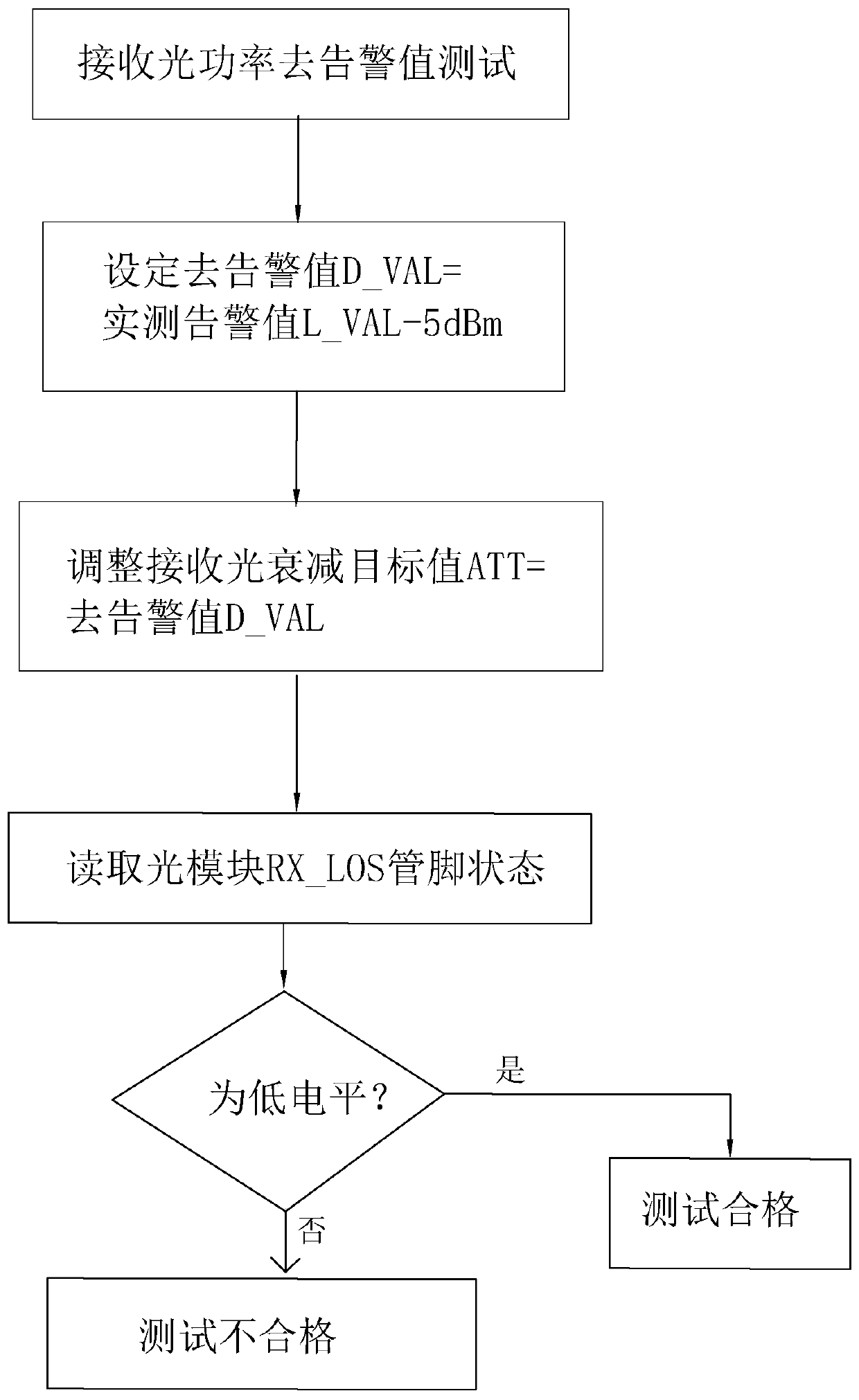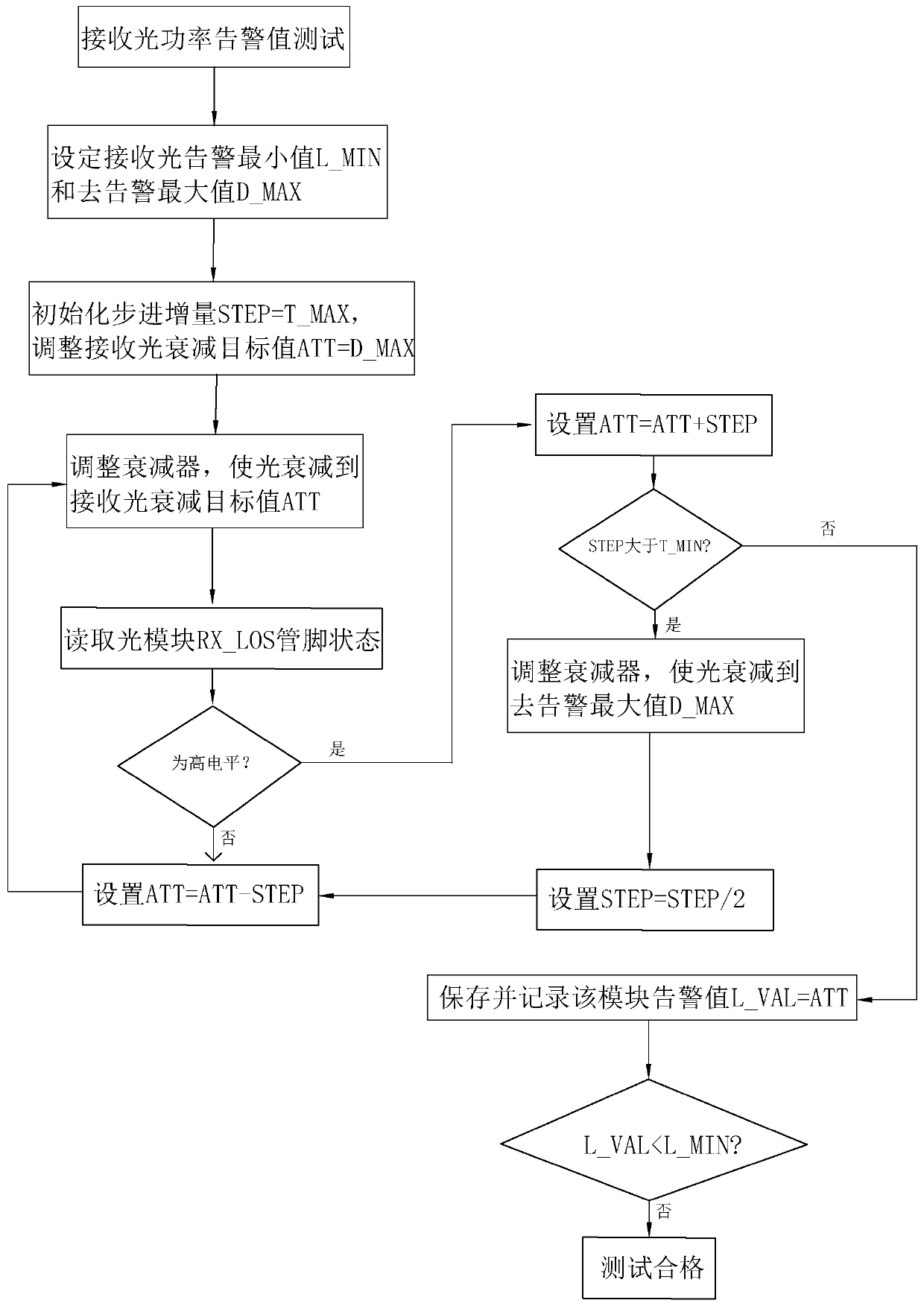Received signal alarm and alarm value removal test algorithm suitable for optical module
A technology for receiving signals and alarm values, which is applied in the field of optical communication, can solve the problems of not being able to adapt to the operation requirements of optical module automatic test software, difficult to control the attenuation speed of received light and test accuracy, and many steps for calculating alarm values, so as to reduce the number of receiving errors. Test steps for alarm values, improve test efficiency, and reduce the effect of test steps
- Summary
- Abstract
- Description
- Claims
- Application Information
AI Technical Summary
Problems solved by technology
Method used
Image
Examples
Embodiment 1
[0039] refer to figure 1 and figure 2 , which is a test algorithm for receiving signal alarm and de-alarm value disclosed by the present invention, the specific steps of the test algorithm are:
[0040] S01: Set the minimum allowable receiving light alarm value to L_MIN, set the allowable maximum receiving light de-alarm value to D_MAX, set the maximum receive light power increment T_MAX, set the receive light power minimum increment T_MIN, define The measured optical module RX_LOS is at a high level when the received optical power is in the alarm state, and the measured optical module RX_LOS is at a low level when the received optical power is in the alarm state;
[0041]S02: Test the alarm value of the received signal, initialize the step increment STEP of the optical attenuation value to be equal to the maximum increment of the received optical power T_MAX, and initialize the target value of the received optical attenuation ATT to be equal to the maximum value D_MAX of th...
Embodiment 2
[0059] In one embodiment, an optical module device is provided. The optical module device is composed of an optoelectronic device, a functional circuit, and an optical interface. The receiving end then converts the optical signal into an electrical signal. When the optical module device is tested, a test algorithm for receiving signal alarm and de-alarm value is implemented.
[0060] The specific steps of the test algorithm are:
[0061] S1: After accurately measuring the measured alarm value L_VAL, set the de-alarm value D_VAL equal to the measured alarm value L_VAL-5dBm;
[0062] S2: Adjust the attenuation of the optical attenuator so that the received light attenuation target value ATT is equal to the alarm value D_VAL;
[0063] S3: Read the state of the RX_LOS pin of the optical module under test, and judge whether it is low level;
[0064] S4: If the state of the RX_LOS pin of the tested optical module is low level, the test is passed; if the state of the RX_LOS pin of...
Embodiment 3
[0066] In one embodiment, a storage medium is provided, on which a computer program is stored, and when the computer program is executed by a processor, the following steps are implemented:
[0067] The specific steps of the test algorithm are:
[0068] S1: After accurately measuring the measured alarm value L_VAL, set the de-alarm value D_VAL equal to the measured alarm value L_VAL-5dBm;
[0069] S2: Adjust the attenuation of the optical attenuator so that the received light attenuation target value ATT is equal to the alarm value D_VAL;
[0070] S3: Read the state of the RX_LOS pin of the optical module under test, and judge whether it is low level;
[0071] S4: If the state of the RX_LOS pin of the tested optical module is low level, the test is passed; if the state of the RX_LOS pin of the tested optical module is not low level, the test is failed.
PUM
 Login to View More
Login to View More Abstract
Description
Claims
Application Information
 Login to View More
Login to View More - R&D
- Intellectual Property
- Life Sciences
- Materials
- Tech Scout
- Unparalleled Data Quality
- Higher Quality Content
- 60% Fewer Hallucinations
Browse by: Latest US Patents, China's latest patents, Technical Efficacy Thesaurus, Application Domain, Technology Topic, Popular Technical Reports.
© 2025 PatSnap. All rights reserved.Legal|Privacy policy|Modern Slavery Act Transparency Statement|Sitemap|About US| Contact US: help@patsnap.com



